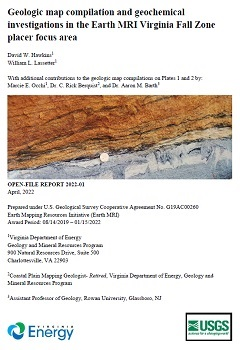
|

 


 Your Price: $0.00 Your Price: $0.00
 Model
Number: 3085 Model
Number: 3085


|
By Hawkins, D.W., and Lassetter, W.L., with contributions to the geologic map compilations by Barth, A.M., Berquist, C.R., Jr., and Occhi, M.E., 2022, 50 p. plus Appendices. In support of the U.S. Geological Survey’s Earth Mapping Resources Initiative (Earth MRI), Virginia Energy scientists assessed heavy mineral sand placer deposits in the Fall Zone and Coastal Plain of Virginia that may host economic minerals such as ilmenite, rutile, leucoxene, monazite, and zircon. Ti- and Zr-bearing minerals have been historically mined for commercial value near Stony Creek and Emporia, Virginia, respectively. Four project areas were chosen based on geophysical anomalies from airborne radiometric and stream sediment geochemical data from existing national datasets. Existing geologic map data were compiled at the 1:100,000 scale and supplemented with new geologic mapping for these four project areas. Virginia Energy collected 53 samples to characterize geologic units and assess the likelihood for economic mineral occurrences. Heavy mineral concentrates from the sediment samples indicate higher total heavy mineral (THM) fractions were most common along the Fall Zone in sediments of the Cold Harbor formation and from stream sediment samples draining Neoproterozoic metasedimentary and metavolcanic rocks of the Roanoke Rapids terrane. Laboratory analysis of mineral concentrates yielded a THM range of ~1% to 13% of the total bulk sample, which consisted mostly of ilmenite, rutile, and zircon as the dominant economic minerals. Monazite was detected at concentrations of less than 2% of the THM fractions in 20 mineral concentrates. Laboratory analytical results indicate enrichments of light rare earth elements (REE), particularly cerium and lanthanum. The REE trends observed in samples from the available laboratory data suggest that other unidentified REE-bearing minerals may be present. This technical report includes two 1:100,000-scale digital geologic maps with a full explanation of map units. A Geologic Map Schema (GeMS) Level-2 compliant geodatabase, shapefiles, and associated metadata are available upon request. Please note that Appendix D includes a supplementary laboratory report that was amended to this file on May 13, 2022. This laboratory data was received after the release of the report, and should be consulted as supplemental data which is not included in the report narrative. A correction was made to the report abstract and was amended to this file on July 19, 2022. No additional revisions were made to the report
narrative. A cartographic display correction was made to Plate 1 and Plate 2 on November 16, 2022. Online only.
|
|